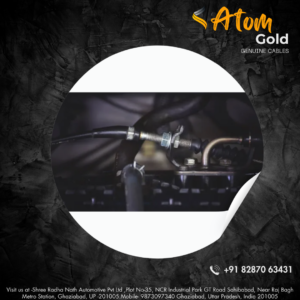The accelerator cable, also known as the throttle cable, plays a critical role in your car’s performance. It connects the accelerator pedal to the throttle body, controlling the engine’s speed by regulating the amount of air entering the engine. Over time, this cable can wear out, leading to issues that affect your car’s drivability and safety. Recognizing the signs of a failing accelerator cable helps you address the problem before it leads to more significant damage or a dangerous situation on the road. Here are the common symptoms to watch for:

1. Delayed or Unresponsive Acceleration
A delay in acceleration when you press the pedal is one of the most noticeable signs of a failing accelerator cable. If your car feels sluggish or slow to respond when you try to accelerate, the cable might be worn or stretched. A stretched cable can’t pull the throttle open quickly, leading to a lag in the engine’s response. This delay can be particularly dangerous when you need to accelerate quickly, such as when merging onto a highway or overtaking another vehicle.
2. Sticky or Stiff Pedal
A sticky or stiff accelerator pedal is another common symptom. You might notice that the pedal doesn’t return to its original position smoothly after you press it or that it requires more effort to push down. This problem can occur if the cable is frayed or if debris or corrosion inside the cable housing causes resistance. A sticky or stiff pedal not only makes driving uncomfortable but can also lead to uneven acceleration, which is hazardous in traffic.
3. Engine Surging or Hesitation
Engine surging or hesitation during acceleration can also indicate a failing accelerator cable. If the cable is frayed or sticking, it may not move smoothly, leading to irregular throttle control. This irregularity can cause the engine to suddenly rev up or lose power, which is disconcerting and potentially dangerous, especially at high speeds. While this symptom can be related to other issues, the accelerator cable is a likely culprit.
4. Visible Damage to the Cable
Sometimes, the signs of a failing accelerator cable are visible. If you see fraying, kinks, or corrosion on the cable, it’s a clear indication that the cable is deteriorating and needs replacement. Regularly inspecting the cable for visible damage can help you catch the problem early before it leads to more severe issues. If you’re unsure how to inspect the cable, a professional mechanic can perform a thorough inspection during routine maintenance.
5. Unusual Engine Noise
A failing accelerator cable can cause unusual noises from the engine, particularly when accelerating. You might hear a clicking, snapping, or grinding sound as the frayed or damaged cable struggles to move within its housing. These noises are a warning sign that something is wrong, and the cable may be on the verge of breaking. Ignoring these sounds could lead to a complete cable failure, leaving you unable to control the engine’s speed.
6. Increased Engine RPMs Without Acceleration
If the engine RPMs (revolutions per minute) increase when you press the accelerator, but the car doesn’t accelerate as expected, it could indicate a problem with the accelerator cable. A stretched or damaged cable might not fully open the throttle, causing the engine to rev higher without a corresponding increase in speed. While this symptom can also relate to other issues, such as a slipping clutch, the accelerator cable is a potential cause.
7. Check Engine Light
A failing accelerator cable can sometimes trigger the check engine light. Modern vehicles have sensors that monitor the throttle position and related components. If the cable isn’t functioning correctly, it can send erratic signals to the engine control unit (ECU), causing the check engine light to come on. If your check engine light is illuminated and you’re experiencing any of the other symptoms mentioned, it’s crucial to have your vehicle inspected by a professional to determine the exact cause.
8. Complete Failure to Accelerate
In the worst-case scenario, a failing accelerator cable can lead to a complete failure to accelerate. This can happen if the cable snaps or becomes completely disconnected from the throttle body or accelerator pedal. If this occurs, you’ll lose control over the engine’s power, leaving you unable to accelerate. A complete failure of the accelerator cable is not only inconvenient but can be extremely dangerous, especially if it happens while driving. If you experience a sudden loss of acceleration, pull over safely and call for assistance.
Causes of Accelerator Cable Failure
Understanding the common causes of accelerator cable failure can help you prevent the issue or address it before it becomes severe. Here are the most common causes:
Wear and Tear
Constant movement and tension on the accelerator cable can cause it to wear out over time. The cable can become stretched, frayed, or even snap due to the repeated stress of accelerating and decelerating.
Corrosion
Corrosion is common in regions with high humidity or where road salt is used during winter. The metal components of the accelerator cable can rust, leading to stiffness or binding within the cable housing.
Improper Installation or Adjustment
If the accelerator cable isn’t installed or adjusted correctly, it can lead to premature wear or improper functioning. An improperly adjusted cable can cause too much slack, leading to delayed acceleration, or it can be too tight, causing the throttle to be partially open at all times.
Physical Damage
Physical damage to the cable, such as from an accident or impact, can cause it to kink, fray, or become misaligned. Any damage to the cable housing can also lead to issues with the cable’s movement.
What to Do If You Suspect a Failing Accelerator Cable
If you suspect your accelerator cable is failing, it’s crucial to act promptly to avoid potential safety hazards. Here’s what you should do:
Inspect the Cable
If you’re comfortable doing so, visually inspect the accelerator cable for any signs of wear, fraying, or damage. Check the connections at both the throttle body and the accelerator pedal.
Consult a Mechanic
If you’re unsure about the condition of the cable or if you notice any of the symptoms mentioned, consult a professional mechanic. They can perform a thorough inspection and determine whether the cable needs to be repaired or replaced.
Replace the Cable
If the cable is damaged, frayed, or stretched, it will need to be replaced. Accelerator cable replacement is a relatively straightforward and inexpensive repair, but it’s crucial for maintaining the safety and performance of your vehicle.
Regular Maintenance
To prevent accelerator cable failure, make sure your vehicle undergoes regular maintenance. This includes inspecting the cable during routine services and addressing any issues before they escalate.
Conclusion
The accelerator cable is a vital component of your vehicle’s throttle system, and its proper functioning is essential for safe and responsive driving. Recognizing the signs of a failing accelerator cable, such as delayed acceleration, a sticky pedal, or unusual engine noise, can help you address the issue before it becomes a serious problem. Regular inspections and timely replacement of the cable ensure that your vehicle remains reliable and safe on the road. If you experience any of the symptoms discussed, don’t hesitate to seek professional assistance to keep your car running smoothly.
